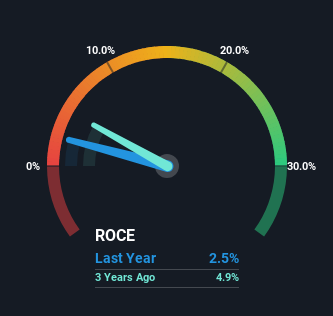- China
- /
- Metals and Mining
- /
- SHSE:600010
Be Wary Of Inner Mongolia Baotou Steel Union (SHSE:600010) And Its Returns On Capital

To find a multi-bagger stock, what are the underlying trends we should look for in a business? Typically, we'll want to notice a trend of growing return on capital employed (ROCE) and alongside that, an expanding base of capital employed. Put simply, these types of businesses are compounding machines, meaning they are continually reinvesting their earnings at ever-higher rates of return. In light of that, when we looked at Inner Mongolia Baotou Steel Union (SHSE:600010) and its ROCE trend, we weren't exactly thrilled.
Understanding Return On Capital Employed (ROCE)
For those who don't know, ROCE is a measure of a company's yearly pre-tax profit (its return), relative to the capital employed in the business. The formula for this calculation on Inner Mongolia Baotou Steel Union is:
Return on Capital Employed = Earnings Before Interest and Tax (EBIT) ÷ (Total Assets - Current Liabilities)
0.025 = CN¥2.1b ÷ (CN¥153b - CN¥66b) (Based on the trailing twelve months to March 2024).
Thus, Inner Mongolia Baotou Steel Union has an ROCE of 2.5%. Ultimately, that's a low return and it under-performs the Metals and Mining industry average of 6.7%.
View our latest analysis for Inner Mongolia Baotou Steel Union

In the above chart we have measured Inner Mongolia Baotou Steel Union's prior ROCE against its prior performance, but the future is arguably more important. If you'd like, you can check out the forecasts from the analysts covering Inner Mongolia Baotou Steel Union for free.
The Trend Of ROCE
In terms of Inner Mongolia Baotou Steel Union's historical ROCE movements, the trend isn't fantastic. Around five years ago the returns on capital were 9.0%, but since then they've fallen to 2.5%. However it looks like Inner Mongolia Baotou Steel Union might be reinvesting for long term growth because while capital employed has increased, the company's sales haven't changed much in the last 12 months. It may take some time before the company starts to see any change in earnings from these investments.
On a separate but related note, it's important to know that Inner Mongolia Baotou Steel Union has a current liabilities to total assets ratio of 43%, which we'd consider pretty high. This effectively means that suppliers (or short-term creditors) are funding a large portion of the business, so just be aware that this can introduce some elements of risk. Ideally we'd like to see this reduce as that would mean fewer obligations bearing risks.
The Bottom Line
To conclude, we've found that Inner Mongolia Baotou Steel Union is reinvesting in the business, but returns have been falling. Since the stock has declined 11% over the last five years, investors may not be too optimistic on this trend improving either. On the whole, we aren't too inspired by the underlying trends and we think there may be better chances of finding a multi-bagger elsewhere.
If you'd like to know about the risks facing Inner Mongolia Baotou Steel Union, we've discovered 1 warning sign that you should be aware of.
While Inner Mongolia Baotou Steel Union isn't earning the highest return, check out this free list of companies that are earning high returns on equity with solid balance sheets.
New: AI Stock Screener & Alerts
Our new AI Stock Screener scans the market every day to uncover opportunities.
• Dividend Powerhouses (3%+ Yield)
• Undervalued Small Caps with Insider Buying
• High growth Tech and AI Companies
Or build your own from over 50 metrics.
Have feedback on this article? Concerned about the content? Get in touch with us directly. Alternatively, email editorial-team (at) simplywallst.com.
This article by Simply Wall St is general in nature. We provide commentary based on historical data and analyst forecasts only using an unbiased methodology and our articles are not intended to be financial advice. It does not constitute a recommendation to buy or sell any stock, and does not take account of your objectives, or your financial situation. We aim to bring you long-term focused analysis driven by fundamental data. Note that our analysis may not factor in the latest price-sensitive company announcements or qualitative material. Simply Wall St has no position in any stocks mentioned.
Have feedback on this article? Concerned about the content? Get in touch with us directly. Alternatively, email editorial-team@simplywallst.com
About SHSE:600010
Inner Mongolia Baotou Steel Union
Inner Mongolia Baotou Steel Union Co., Ltd.
Very low and overvalued.
Market Insights
Community Narratives



